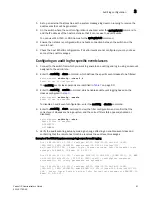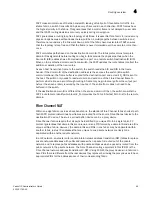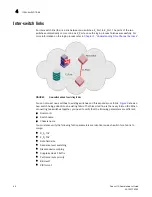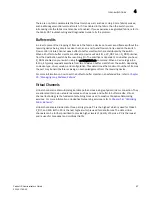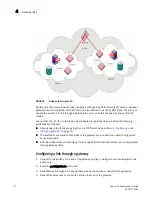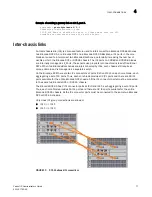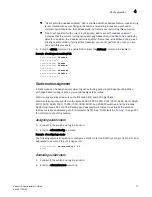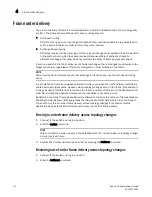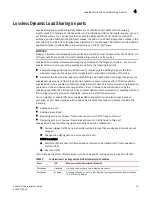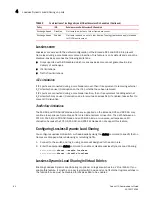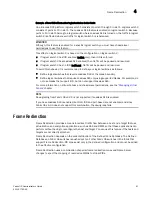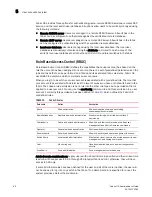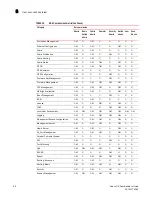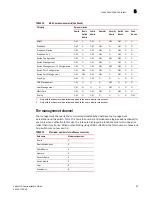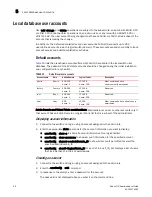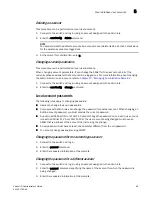
74
Fabric OS Administrator’s Guide
53-1001763-02
Routing policies
4
Each switch can have its own routing policy and different policies can exist in the same fabric.
ATTENTION
For most configurations, the default routing policy is optimal and provides the best performance. You
should change the routing policy only if there is a performance issue that is of concern, or if a
particular fabric configuration or application requires it.
Displaying the current routing policy
1. Connect to the switch and log in as admin.
2. Enter the aptPolicy command with no parameters.
The current policy is displayed, followed by the supported policies for the switch.
Example of the output from the aptPolicy command.
In the following example, the current policy is exchange-based routing (3) with the additional
AP dedicated link policy.
switch:admin>
aptpolicy
Current Policy: 3 1(ap)
3 0(ap): Default Policy
1: Port Based Routing Policy
3: Exchange Based Routing Policy
0: AP Shared Link Policy
1: AP Dedicated Link Policy
Exchange-based routing
The choice of routing path is based on the Source ID (SID), Destination ID (DID), and Fibre Channel
originator exchange ID (OXID), optimizing path utilization for the best performance. Thus, every
exchange can take a different path through the fabric. Exchange-based routing requires the use of
the Dynamic Load Sharing (DLS) feature; when this policy is in effect, you cannot disable the DLS
feature.
Exchange-based routing is also known as Dynamic Path Selection (DPS). DPS is where exchanges
or communication between end-devices in a fabric are assigned to egress ports in ratios
proportional to the potential bandwidth of the ISL or trunk group. When there are multiple paths to
a destination, the input traffic will be distributed across the different paths in proportion to the
bandwidth available on each of the paths. This improves utilization of the available paths, thus
reducing possible congestion on the paths. Every time there is a change in the network (which
changes the available paths), the input traffic can be redistributed across the available paths. This
is a very easy and non-disruptive process when the exchange-based routing policy is engaged.
Port-based
routing
The choice of routing path is based only on the incoming port and the destination domain. To
optimize port-based routing, DLS can be enabled to balance the load across the available output
ports within a domain.
Summary of Contents for 53-1001763-02
Page 1: ...53 1001763 02 13 September 2010 Fabric OS Administrator s Guide Supporting Fabric OS v6 4 0 ...
Page 4: ...iv Fabric OS Administrator s Guide 53 1001763 02 ...
Page 24: ...xxiv Fabric OS Administrator s Guide 53 1001763 02 ...
Page 28: ...xxviii Fabric OS Administrator s Guide 53 1001763 02 ...
Page 32: ...xxxii Fabric OS Administrator s Guide 53 1001763 02 ...
Page 40: ...xl Fabric OS Administrator s Guide 53 1001763 02 ...
Page 42: ...2 Fabric OS Administrator s Guide 53 1001763 02 ...
Page 54: ...14 Fabric OS Administrator s Guide 53 1001763 02 High availability of daemon processes 1 ...
Page 74: ...34 Fabric OS Administrator s Guide 53 1001763 02 Basic connections 2 ...
Page 102: ...62 Fabric OS Administrator s Guide 53 1001763 02 Audit log configuration 3 ...
Page 214: ...174 Fabric OS Administrator s Guide 53 1001763 02 Management interface security 7 ...
Page 228: ...188 Fabric OS Administrator s Guide 53 1001763 02 Brocade configuration form 8 ...
Page 276: ...236 Fabric OS Administrator s Guide 53 1001763 02 Creating a logical fabric using XISLs 10 ...
Page 404: ...364 Fabric OS Administrator s Guide 53 1001763 02 ...
Page 440: ...400 Fabric OS Administrator s Guide 53 1001763 02 Performance data collection 17 ...
Page 480: ...440 Fabric OS Administrator s Guide 53 1001763 02 F_Port masterless trunking 19 ...
Page 494: ...454 Fabric OS Administrator s Guide 53 1001763 02 Buffer credit recovery 20 ...
Page 574: ...534 Fabric OS Administrator s Guide 53 1001763 02 Hexadecimal overview E ...


